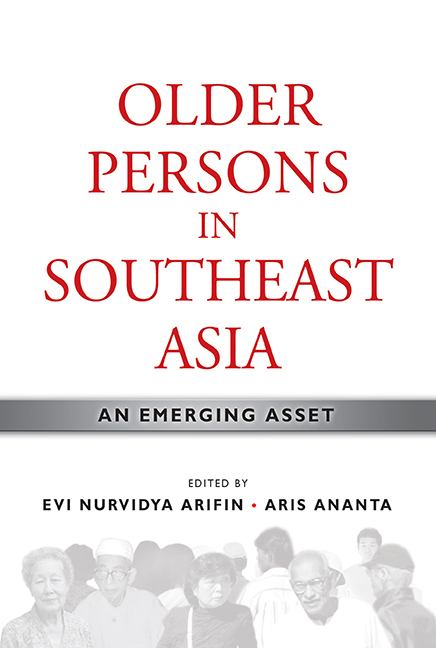Book contents
- Frontmatter
- Contents
- List of Tables
- List of Figures
- Foreword by Hal Hill
- Message from the Director
- Preface
- Contributors
- PART I INTRODUCTION
- PART II OLD-AGE INCOME SECURITY
- 3 Economics and Old Age: The Singapore Experience
- 4 National Long-Term-Care Severe Disability Insurance in Singapore
- 5 Social Security and Health Care Financing for Older Persons in Thailand: New Challenges
- 6 An Exploration of a Universal Non-contributory Pension Scheme in Vietnam
- PART III EMPLOYMENT AND OTHER SOURCES OF FINANCIAL CONTRIBUTION
- PART IV AGEING, MIGRATION, AND DEVELOPMENT
- PART V ROLES OF GOVERNMENT AND CIVIL SOCIETY
- Index
4 - National Long-Term-Care Severe Disability Insurance in Singapore
from PART II - OLD-AGE INCOME SECURITY
Published online by Cambridge University Press: 21 October 2015
- Frontmatter
- Contents
- List of Tables
- List of Figures
- Foreword by Hal Hill
- Message from the Director
- Preface
- Contributors
- PART I INTRODUCTION
- PART II OLD-AGE INCOME SECURITY
- 3 Economics and Old Age: The Singapore Experience
- 4 National Long-Term-Care Severe Disability Insurance in Singapore
- 5 Social Security and Health Care Financing for Older Persons in Thailand: New Challenges
- 6 An Exploration of a Universal Non-contributory Pension Scheme in Vietnam
- PART III EMPLOYMENT AND OTHER SOURCES OF FINANCIAL CONTRIBUTION
- PART IV AGEING, MIGRATION, AND DEVELOPMENT
- PART V ROLES OF GOVERNMENT AND CIVIL SOCIETY
- Index
Summary
To appreciate the issues involved in a long-term-care disability insurance (LTCDI) scheme, one must first understand the nature of disability in older persons: its epidemiology, the natural progression, and prevention. These issues will be discussed in the first part of this chapter, followed up by a brief overview of LTCDI schemes around the world. However, for the second part, Singapore will be used to contextualize the discussion on the non-financial aspects of such schemes (that is, social, rehabilitative, costs of care, life expectancy, and public policy considerations).
Epidemiology of Disability in Older Persons
Disability is often associated with older persons, especially the old-old (age 75 years and above). Frailty and disability among older persons accounts for the burden of care often feared by governments of countries with an aged population, defined by the Population Division of the Department of Economic and Social Affairs, United Nations, as when 10 per cent or more of its population is aged 60 years and above (United Nations 2002). In the United Kingdom where 20 per cent of its population is aged 60 years and above (UK National Statistics Online 2001), a study by Melzer et al. (1999) found that 15.7 per cent of those aged 65 years and above was disabled and that there were three times more disabled persons aged 75 years and above (old-old) than those aged 64 to 74 years (young-old). In Singapore, where only 8.5 per cent of its population was aged 65 years and above in 2006 (Ministry of Health 2006), a study by Yadav in 1997 found that 20.5 per cent of Singaporeans aged 60–64 years was handicapped whereas 64.6 per cent of those aged above 85 years was handicapped (Yadav 2001). He also found that both the incidence and severity of handicap increased with greater age. Yadav had defined a handicap as “a limitation to perform one or more tasks associated with daily living (namely self-care, mobility, and verbal communication) due to a disability”, which was based on the World Health Organization' (WHO) definitions used in the International Classification of Impairments, Disabilities, and Handicaps (ICIDH).
- Type
- Chapter
- Information
- Older Persons in Southeast AsiaAn Emerging Asset, pp. 97 - 115Publisher: ISEAS–Yusof Ishak InstitutePrint publication year: 2009

